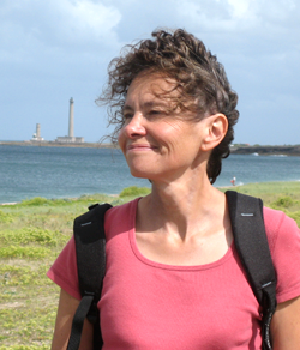
Catherine DAMERVAL
dernières mises à jour 14/12/2020
-
01 69 33 23 66
catherine.damerval@inrae.fr
Génétique, Épigénétique et Évolution de la Morphogenèse Florale
CNRS, Directrice de Recherche
publications - orcid
Position
-
Senior Researcher (DR2) Centre National de la Recherche Scientifique (CNRS)
-
Deputy director of UMR Quantitative Genetics & Evolution - Le Moulon
-
Head of GE2MorF team (Genetics, Epigenetics and Evolution of Floral Morphogenesis)
Research interests
- My current research is in the field of Evolutionary Developmental Genetics (evo-devo). Evo-devo brings additional important complement to the Modern Synthesis theory at least for multicellular organisms, pinpointing the importance of development as a potential source of constraints that interplay with natural selection to produce morphological diversity in the course of evolution.
Since the 2000s, I have been focussing on the evolution of floral traits, namely floral symmetry and petal formation and shape (1 and 2, 4, 6, 8 and 9). I chose these traits because they have evolved several times independently during angiosperm diversification, most probably as a result of convergent selective pressures for pollination efficiency.
Such traits are interesting subjects for evo-devo research, because they provide the opportunity to examine the relative importance of developmental/historical constraints and selection in morphological evolution. The comparative analyses of genes and gene networks in a phylogenetic framework allow the generality of the toolkit and evolutionary tinkering concepts to be appreciated.
-
External Collaborators on my present research: Sophie Nadot (ESE), Florian Jabbour (MNHN), Etienne Delannoy (URGGV, IPS2), Patrick Laufs (IJPB).
-
My previous research has also been built on my persistent interest in the genetic and molecular bases of morphological diversity in plants. The underlying hypothesis of my approaches has been that the polymorphism of regulatory factors is of primary importance for morphological evolution.
I have used quantitative proteomics to have an access to the variability of regulatory mechanisms of gene expression in maize and to decipher their genetic architecture (11). I analyzed the molecular polymorphism and diversity of candidate genes in wild and cultivated accessions in the genus Zea, to get an insight into the molecular bases of the response to selection for kernel storage compounds during and after domestication (5, 7). I have also been interested in the evolutionary history of gene families (duplication, gene loss, patterns of selection), some members of which have been found to play important roles in morphological variation (3, 10).
Some past PhD students
- Beatriz Gonçalves, Post-Doc IJPB
- Florian Jabbour, Research Associate, MNHN Paris
- Judith Burstin, Senior Researcher, Institut National de la Recherche Agronomique (INRA)
Research management
- Elected member of CCSU 64-69 (Université Paris-Sud) from 2010.
- Member of CSS EGBIP (INRA), 2011-2014.
- Member of the section 29 of the National Comitee for Scientific Research (CoNRS) from 2012.
- 2010-2013: Director of Federal Institute for Research “the Plant and its environment” (IFR87, closed since December 2013)
Publications
- Conde E Silva N., Leguilloux M., Bellec A., Rodde N., Aubert J., Manicacci D., Damerval C. , Berges H., Deveaux Y., Bartlett M.. (2023) A MITE insertion abolishes the AP3-3 self-maintenance regulatory loop in apetalous flowers of Nigella damascena. Journal of Experimental Botany, 5 (74) 1448-1459
- Damerval C. , Claudot C., Le Guilloux M., Conde E Silva N., Brunaud V., Soubigou-Taconnat L., Caius J., Delannoy E., Nadot S., Jabbour F., Deveaux Y.. (2022) Evolutionary analyses and expression patterns of TCP genes in Ranunculales. Front Plant Sci, (13) 1055196
- Delpeuch P., Jabbour F., Damerval C. , Schönenberger J., Pamperl S., Rome M., Nadot S.. (2022) A flat petal as ancestral state for Ranunculaceae. Front Plant Sci, (13) 961906
- Deveaux Y., Conde e Silva N., Manicacci D., Le Guilloux M., Brunaud V., Belcram H., Joets J., Soubigou-Taconnat L., Delannoy E., Corti H., Balzergue S., Caius J., Nadot S., Damerval C. . (2021) Transcriptome Analysis Reveals Putative Target Genes of APETALA3-3 During Early Floral Development in Nigella damascena L.. Front. Plant Sci., (12) 660803
- Jabbour F., Pasquier PED., Chazalviel L., Guilloux ML., Conde e Silva N., Deveaux Y., Manicacci D., Galipot P., Heiss AG., Damerval C. . (2021) Evolution of the distribution area of the Mediterranean Nigella damascena and a likely multiple molecular origin of its perianth dimorphism. Flora, (274) 151735
- Carrive L., Domenech B., Sauquet H., Jabbour F., Damerval C. , Nadot S.. (2020) Insights into the ancestral flowers of Ranunculales. Botanical Journal of the Linnean Society, 1 (194) 23-46
- Espinosa F., Damerval C. , Le Guilloux M., Deroin T., Wang W., Pinedo-Castro M., Nadot S., Jabbour F.. (2020) Homeosis and delayed floral meristem termination could account for abnormal flowers in cultivars of Delphinium and Aquilegia (Ranunculaceae). Botanical Journal of the Linnean Society, boaa063
- Jabbour F., Pasquier PED., Chazalviel L., Guilloux ML., Condee Silva N., Deveaux Y., Manicacci D., Galipot P., Heiss AG., Damerval C. . (2020) Evolution of the distribution area of the Mediterranean Nigella damascena and a likely multiple molecular origin of its perianth dimorphism. Flora, 151735
- Damerval C. , Citerne H., Conde E Silva N., Deveaux Y., Delannoy E., Joets J., Simonnet F., Staedler Y., Schönenberger J., Yansouni J., Le Guilloux M., Sauquet H., Nadot S.. (2019) Unraveling the Developmental and Genetic Mechanisms Underpinning Floral Architecture in Proteaceae. Front Plant Sci, (10) 18
- Damerval C. , Othman WB., Manicacci D., Jabbour F.. (2018) Distribution area of the two floral morphs of Nigella damascena L. (Ranunculaceae): A diachronic study using herbarium specimens collected in France. Botany Letters, 3-4 (165) 396-403
- Damerval C. , Nadot S.. (2017) Letter to the 21st century botanist: “What is a flower?” 6. The evo-devo of floral symmetry. Botany Letters, 3 (164) 193-196